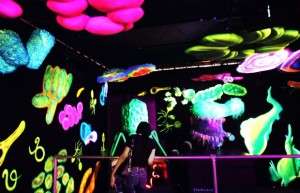We leave a trail of microbes on every surface we touch, from pens and keyboards to door handles and elevator buttons. Everywhere you go, in everything you do, you are surrounded by an aura of microbes. They drift down from your hair when you scratch your head, they fly off your hand when you wave to your friend, and they spew out of your mouth when you talk. Even when you sit around doing nothing, you’re sitting in your own, personal microbial bubble. In addition to leaving our mark on surfaces, we’re also emitting a bacterial signature into the air, what scientists call a “microbial cloud” and according to a new study conducted by the Biology and the Built Environment Center at the University of Oregon, this invisible aura is so specific that it can be used to distinguish between individual people.
The University of Oregon study, led by data scientist James Meadow, examined the microbial cloud signatures of 11 people. Each subject was confined to the tightly controlled experiment room for four hours as their microbiome colonized the space. Samples were collected from the air and the floor in a three-foot radius surrounding each subject, then run through DNA sequencing to identify specific bacterial species. This study focused on the commensal, or “good,” bacteria we all have in and on our bodies, including Streptococcus, Propionibacterium, and Corynebacterium. The researchers found that, within four hours, most people in the study could be identified by the amount and diversity of bacteria in their respective clouds.
Humans give off about 1 million biological particles per hour just by exhaling, sloughing off skin cells, and radiating hot air from the tops of their heads. This process depends a lot on the ventilation of a room. “Skin cells might settle out pretty quickly, within a few feet of you, but individual bacteria and those really small particles might stay aloft for hours and hours if there’s any kind of minor turbulence in the air around you,” says Meadow. The unique composition of each person’s cloud varies with hygiene and environment. People with beards, for instance, shed more bacteria because the surface area of their facial hair provides more room for them to proliferate. Swimmers who immerse themselves in chlorine every day will have significantly different cloud signatures. In Meadow’s study, microbes went beyond revealing that a human was present in the room they were able to indicate which human.
The implications for forensic science are exciting. What if you could tell who committed a crime based on the microbes they left behind? These signatures could, in some cases, reveal “not just who’s there, but potentially where they’ve been and what they’ve been doing,” Meadow says. For example, people in different countries will have different microbial signatures because of environmental factors such as soil, water, and air quality. But it’s unclear whether a microbial cloud signature could be as conclusive in the same way as a fingerprint. “One important difference is that our fingerprints don’t change over time, whereas our microbiome likely does change at least a bit depending on diet, activities, and location,” Meadow says. “For our study, it was true at one time point.”
A number of recent studies have shown that indoor spaces start to look like us, microbially, within hours. But there’s still a lot we don’t know about how these signatures form, proliferate, and change over time. “If someone comes and types on my keyboard, are their fingers going to start harboring some of my skin microbiome?” Meadow says. “We don’t really know that yet.” Further research could transform efforts to control the spread of infectious disease. “If we knew a little more about how our microbial cloud fills the air around us, and how that is influenced by air moving around in buildings, I think it could help a lot,” says Meadow. In the future, health professionals might have a better sense of the scope of outbreaks in public places and buildings could be designed with the interaction of human microbial clouds in mind
That said, there’s no reason to fear the bacteria your fellow commuters are emitting. These auras are just a natural part of being human. Well, the human body does spew a cloud, but instead of dirt it contains millions of microorganisms. “It’s a microscopic cloud that’s really hard to see.” Each of us carries around millions of microorganisms, including bacteria, fungi and viruses, on the inner and outer surfaces of our bodies. Most of them aren’t dangerous. In fact, growing evidence indicates that they help us in lots of ways. Scientists call this collection of organisms our microbiome. “We know that if you live with people, and even if you just work with people, your microbial communities come to resemble theirs over time,” Knight says. “And in the past we used to think that was due to touch. It may be just that you’re releasing microbes into the air and some of those microbes are colonizing the people you’re with.” Knight says there may be a wealth of information yet to be decoded from your microbiome that could one day yield information about “where you’ve been, who you’ve been in contact with” and more.
For more information please visit: http://www.wired.com


Comments are closed.